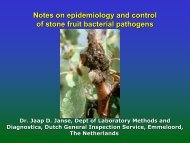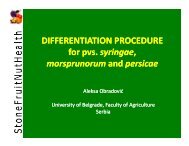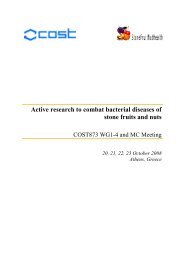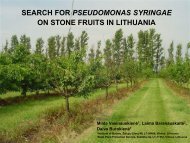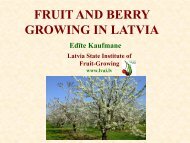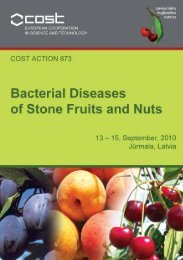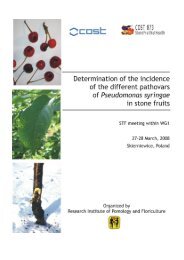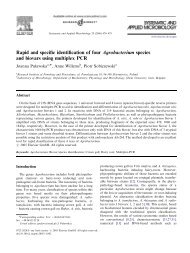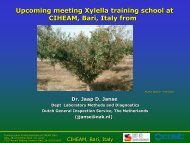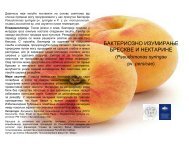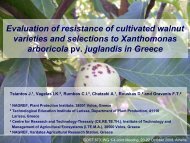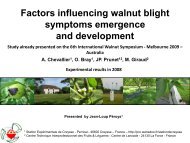Annual progress report - Cost 873
Annual progress report - Cost 873
Annual progress report - Cost 873
Create successful ePaper yourself
Turn your PDF publications into a flip-book with our unique Google optimized e-Paper software.
Monitoring Progress Report – 2009<br />
COST <strong>873</strong> – Bacterial Diseases of Stone Fruits and Nuts<br />
_________________________________________________________________________________<br />
23. Scortichini, M. 2006. Severe outbreaks of Pseudomonas syringae pv. syringae on new apricot cultivars in<br />
central Italy. J. Plant Pathol. 88:S68.<br />
24. Liguori, R., Calvi, P., Bassi, R., Pelliconi, F., Fagioli, L., Finotti, A., Scortichini, M. 2006. Efficacia di<br />
campo di acibenzolar-S-methyl (Bion) nei confronti della maculatura batterica del pesco, causata da<br />
Xanthomonas arboricola pv. pruni. Atti Giornate Fitopatol. 2:131-134.<br />
25. Kadlicskó S., Pintér Cs., Fischl G., Simon F., Süle S., Dankó J., Jakab A., Makó Sz. 2007. A dió<br />
károsítóiról: vizsgálatok és eredmények. Agrofórum Extra, 19. 54-60. (Investigations and results on walnut<br />
diseases).<br />
26. Simon F., Fischl G., Kadlicskó S., Pintér Cs., Dankó J., and SSüle S. 2007. Phytopathological problems<br />
and solutions in walnut orchards along Lake Balaton. Ghent. (in press).<br />
27. Pintér Cs., Süle S., és Dankó J. 2006. A dió bakteriózis elleni védekezés optimális idejének megállapítása.<br />
XVI. Keszthelyi Növényvédelmi Fórum, Összefoglaló, 77.p. (Optimal times for protection agains bacterial<br />
diseases of walnut).<br />
28. Dankó J., Fischl G., Jakab A., Kadlicskó S., Makó Sz., Pintér Cs. és Süle S. (2007): Növénykórtani gondok<br />
és megoldások a dióültetvényekben. XVII. Keszthelyi Növényvédelmi Fórum, 2007. kiadványa, 129-131.p.<br />
(Phytopathological problems and solutions in walnut orchards).<br />
29. Dallai D. and E. Stefani, 2007. Genetic variations among Xanthomonas arboricola pv. pruni populations<br />
from peach orchards in Romagna. In: Proceedings of SIPAV Conference, Perugia, Italy, September 18-21.<br />
30. Biondi E., F. Bini, P. Lancioni, F. Anaclerio, A. Brunelli and C. Bazzi, 2006. Biological control agents as<br />
tools against some emergent bacterial plant diseases in Italy: A concrete perspective. Mitt. Biol.<br />
Bundesanst. Land. Forstwirtsch. 408. 170-176. (PDF not available)<br />
31. M. Vasinauskienė, D. Burokienė, V. Snieškienė, 2007: Lietuvoje augančių riešutmedţių (Junglands spp.)<br />
bakterinės ligos. – Ţvilgsnis į mikroorganizmų pasaulį. Gamtamokslinio ugdymo priemonė: 133-136.<br />
32. Giraud M., Prunet J.P., Chevallier A. et Ramain S., 2007. La bactériose du noyer: évolution des populations<br />
de Xanthomonas en verger. Infos-Ctifl n°230, avril 2007 pp.38-42.<br />
33. Dallai D, Stefani, E. 2007. Genetic variations among Xanthomonas arboricola pv. pruni populations from<br />
peach orchards in Romagna. J Plant Pathol 89:S15.<br />
34. Natalini E, M Scortichini. 2007. Variability of the 16S–23S rRNA gene internal transcribed spacer in<br />
Pseudomonas avellanae strains. FEMS Microbiol Lett 271:274 – 280.<br />
35. Bultreys, A. 2007. Siderotyping, a tool to characterize, classify and identify fluorescent<br />
pseudomonads, p 67-90. In A. Varma and S.B. Chincholkar (Eds.), Microbial Siderophores, Soil<br />
Biology, Volume 12, Springer-Verlag Berlin Heidelberg.<br />
36. Garcin A, Prunet J.P., 2008, Réunion du Comité de Coopération Scientifique et Technique (<strong>Cost</strong>) <strong>873</strong><br />
(Murcia, 23-25 octobre 2007): Maladies bactériennes des Fruits à noyaux et à coques. Infos-Ctifl n°240,<br />
avril 2008 pp. 6-7.<br />
37. Vasinauskiene M., Baranauskaite L., Burokiene D., 2008: Bakteriniu kaulavaisiu ligu<br />
pasireiskimas Lietuvoje. - Vytauto Didziojo Universiteto Botanikos sodo rastai, 12 (spaudoje)<br />
(Vasinauskiene M., Baranauskaite L., Burokiene D., 2008: Occurrence of stone fruit bacterial<br />
diseases in Lithuania. - Scripta Horti Botanici Universitetis Vytauti Magni, 12 (in press))<br />
38. Bultreys, A. and I. Gheysen. 2008. Siderophore uses in Pseudomonas syringae identification, p 21-<br />
35. In M. Fatmi et al. (eds), Pseudomonas syringae Pathovars and Related Pathogens-<br />
Identification, Epidemiology and Genomics, Springer.<br />
39. Bultreys, A. 2007. Siderotyping, a tool to characterize, classify and identify fluorescent<br />
pseudomonads, p 67-90. In A. Varma and S.B. Chincholkar (Eds.), Microbial Siderophores, Soil<br />
Biology, Volume 12, Springer-Verlag Berlin Heidelberg.<br />
21




